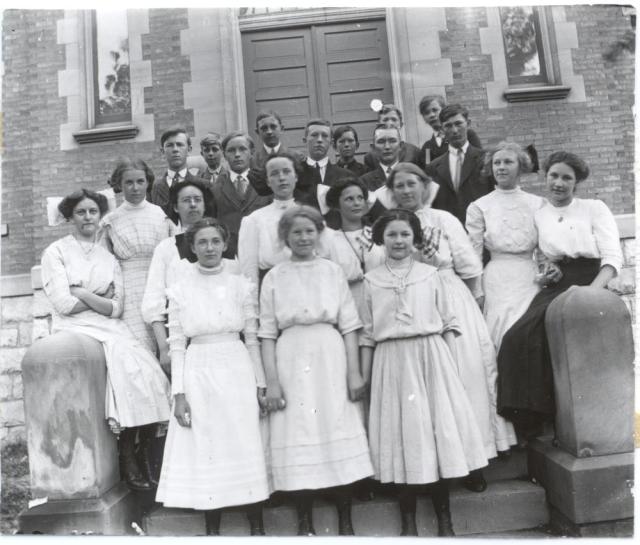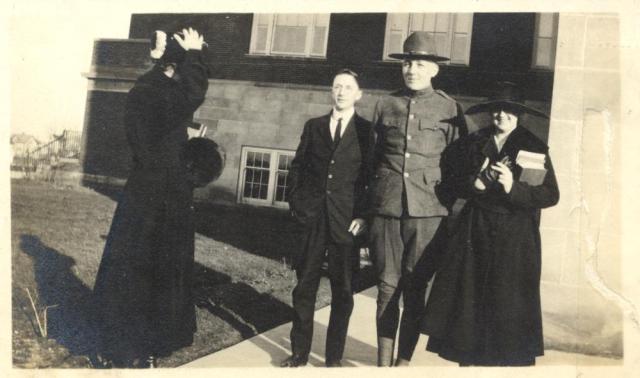Not long after the United States entered the First World War, Bethel Academy graduated its class of 1917, fifteen strong. It had been sixty-five years since Swedish Baptist immigrants founded their first American congregation, yet still one in three of the school’s graduates were natives of Sweden or Norway, and almost all the rest had Scandinavian surnames. That last issue of the Academy’s newspaper, The Acorn, still included a Swedish section. And the seminary with which the Academy shared a campus retained Swedish as its primary language under dean C.G. Lagergren.
In the judgment of longtime Bethel archivist and institutional historian Norris Magnuson, “The super-patriotism of the war era accelerated” the Americanization of the Swedish Baptists. (Here I’m quoting Magnuson’s unpaginated 1984 booklet on Baptist General Conference history, How We Grew.) I’ll have much more to say in coming weeks about the ways that war deepened and perhaps hastened the “Americanization” of Swedish immigrants and their children, but this early, let me set up an interesting contrast:

A group of students at Calvin College in 1918 – Courtesy of Heritage Hall, Calvin College, Grand Rapids, MI
Even if the Great War sped up the process, Magnuson thinks that the Americanization of Swedes was already “inevitable”; fewer and fewer immigrants were arriving (and the war had something to do with this as well) and generations that had never known the old country were assimilating into the mainstream. But among Dutch immigrants, WWI only “intensified the deeper issues of Americanization” in communities like Holland, Michigan and Pella, Iowa. The war “heightened their sense of themselves, of the surrounding society, and of the tension between them….” and led to a postwar backlash at their school, Calvin College.
That according to Calvin historian James Bratt, who observes that World War I “introduced a conflict far more severe than common ethnic tension” into the Dutch-American communities. (See ch. 6 of his Dutch Calvinism in Modern America: A History of a Conservative Subculture.)
Not that the ethnic tension was absent. Bratt mentions, for example, that Dutch farmers “repeatedly found yellow stripes smeared on their barns and unrequested American flags hanging in their church sanctuaries.” To be sure, some of their “American neighbors [were] unable to distinguish between ‘Dutch’ and ‘Deutsch,'” but before 1917, some Dutch Calvinists had been rather stridently pro-neutrality, no doubt remembering how the British had recently treated their Afrikaner cousins.
But the effects of the war went deeper, says Bratt, as “it polarized the celebrators of pure Americanism and those somehow more ‘Dutch.'” Their college in Grand Rapids, Michigan wasn’t immune from that polarization, or the lingering effects of the war.

A Calvin student in uniform, 1918 – Courtesy of the Heritage Center, Calvin College, Grand Rapids, MI
In their short history of Calvin College, Bratt and Ron Wells explain how the war exacerbated preexisting tensions within the Christian Reformed Church and what then was still its two-year school. Kuyperians like history professor Barend Klaas Kuiper believed that if Calvinists were “to stem the cultural tides of unbelief” and “to save the nation from its worst instincts,” then they “should enter America,” including “its more polished precincts.” But more “pietistic” elements within the CRC simply wanted Calvin to remain a “safe place to send their children.” Many in the first camp had championed the war, but for those in the second, the experience of 1917-1918 deepened their suspicion of a college that they saw as losing touch with its heritage. Postwar expansion of what in 1920 became a four-year college didn’t help:
Barely had the first graduating class of the full four-year college marched across the stage in 1921 than the complaint was sounded across the denomination: Had Calvin lost its distinctiveness? Was it not emphasizing physical plant over principle, pursuing worldly eminence instead of simple faithfulness?
Progressive faculty were ousted, and president J.J. Hiemenga’s campaign to boost the school’s endowment raised only 10% of his million-dollar target. “The Christian Reformed were not being tight,” conclude Bratt and Wells, “only scared. Having been force-marched into American life, they were determined to maintain some sort of distance from the world” (Bratt and Wells, “Piety and Progress: A History of Calvin College,” in Richard T. Hughes and William B. Adrian, Models for Christian Higher Education, p. 147).


[…] of it to that of other colleges and universities. Yesterday I considered how WWI served as an engine of “Americanization” at Bethel — and prompted resistance to such assimilation within the Dutch-American […]
[…] and symbolism to support Bethel fundraising during WWII, and how WWI did or didn’t accelerate “Americanization” among the Swedes of Bethel Academy and Seminary and the Dutch of Calvin […]
[…] I’d like to continue a theme that Chris initiated by looking at the faculty of Calvin College as they grappled with Vietnam. I’ll be primarily […]